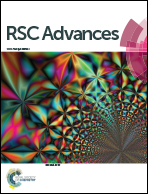Selective colorimetric sensing of fluoride in an aqueous solution by amino-naphthoquinone and its Co(ii), Ni(ii), Cu(ii) and Zn(ii) complexes – effect of complex formation on sensing behaviour†
Abstract
An amino-naphthoquinone ligand and its Co(II), Ni(II), Cu(II) and Zn(II) complexes have been synthesized and characterized using analytical and spectral techniques. The anion sensing behaviour of these receptors is investigated using UV-vis, fluorescence and 1H NMR spectral studies. Electrochemical and DFT computations are also carried out to substantiate the results of spectral studies. The receptors colourimetrically sense fluoride ions selectively and sensitively in aqueous DMF mixtures. The mechanism of sensing involves formation of an H-bond between the N–H group and fluoride ion. The binding constants for the formation of 1 : 1 receptor–fluoride complexes are found to be in the order of 105 M−1. The results indicate that complexation with metal ions not only enhanced the HBD property of the N–H group but also accommodates ≥50% of water in the sensing medium.


 Please wait while we load your content...
Please wait while we load your content...